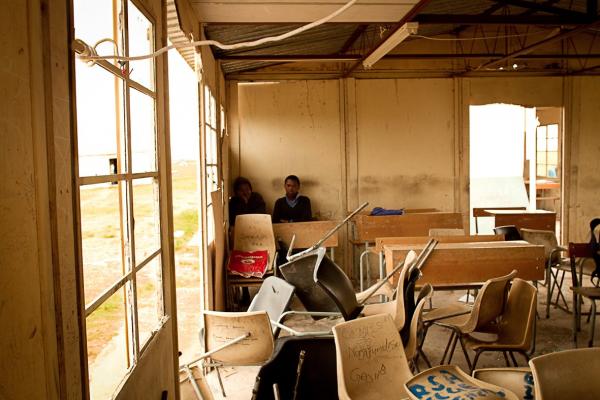Behind the scenes of school infrastructure victory

Doron Isaacs of Equal Education describes the organisation’s campaign that got the Minister of Basic Education to settle their court case last week.
On Monday 12 November I was sitting in a meeting at Equal Education head office in Khayelitsha and noticed the red light flashing on my phone. I read the message from Cameron McConnachie, EE’s attorney at the Legal Resource Centre in Grahamstown, and then interrupted a colleague in mid-sentence to announce that Minister Motshekga wanted to settle the case we’d brought against her almost a year ago.
Four days later we sat across the table from her in the impressive Department of Basic Education head office in Pretoria – proof that the DBE can certainly build when they want to. On the previous occasion that I was there with Equal Education we were not offered even water, but this was a different meeting: the Minister was hospitable and warm, and gracious in acknowledging that she had to settle the case because it “could not be morally defended”.
We now have an agreement that by 15 January the Minister will publish Norms and Standards for School Infrastructure for public comment, which will be open until 31 March. By 15 May we’ll have binding Norms and Standards. The content is for the Minister to determine, but her hands are somewhat bound by the fact that section 5A(2) of the SA School Act says that the “norms and standards … must provide for, but not be limited to … the availability of classrooms, electricity, water, sanitation, a library, laboratories for science, technology, mathematics and life sciences, sport and recreational facilities, electronic connectivity at a school, and perimeter security.” Of course we’re already preparing mobilization to ensure that the final document is a decent one, and will return to court if it isn’t.
There is a great feeling of achievement in EE right now, coupled with some anti-climax at the 11th hour avoidance of what would have been a riveting court case, coupled with great determination and new energy for the work ahead. But how did we get here?
The very first campaign EE conducted in 2008 fixed 500 broken windows in one Khayelitsha high school. The issue was chosen by EE’s members because the classrooms would get cold and wet in winter and windy throughout the year. The successful campaign taught us that the physical condition of a school impacts the relationship students have with that school. Further research confirmed that there is a direct impact on learning outcomes too.
By late 2009 EE had begun to campaign for a national rollout of school libraries. Although we received written assurance from the Minister, and began to work with some provinces on their rollouts, we realised that the campaign needed a stronger footing. It was then that the appeal of norms and standards for school infrastructure began to register.
We discovered that draft norms and standards had been gazetted in late 2008, but had vanished with the departure of Minister Naledi Pandor. We began to campaign for their resurrection. In July 2010 there was a breakthrough: Minister Motshekga published a national policy with promised norms and standards for school infrastructure by 1 April 2011.
I doubt whether many people in the Department of Basic Education were even aware of this little deadline buried in a 60-page policy document, but it became a burning appointment on the calendar of thousands of EE members. The mobilisation had all along been intense. It had included numerous marches and a 24-hour fast by 5000 people, but now it intensified.
On 21 March 2011 over 20,000 EE members and supporters marched on Parliament in what was probably the largest youth march since democracy. The Minister sent a flunky to accept the memorandum, a serious PR blunder that alienated her from EE’s membership. When the 1 April deadline came and went the attitude of EE members hardened still further against the Minister.
Then on 25 June 2011 the Minister did attend and speak at the opening of an education summit hosted by EE. Addressing over 400 delegates from seven provinces she said for the first time that there would be no norms and standards, and offered as justification that her hands were tied by the provinces. But as every EE member knew, this was not true. As the campaign hit a new level of intensity, EE members slept outside Parliament from 12 to 14 July 2011, defying the police on the second night and narrowly avoiding arrest. Minister Motshekga ignored the protests.
Just five days later, EE met lawyers from the Legal Resources Centre and Advocate Geoff Budlender, one of the most experienced human rights lawyers in the world. Until that day Budlender had not been too sanguine about the prospects of a court case, but something clicked for him during that meeting and the case gathered a head of steam quite quickly.
We knew two things from early on. Firstly, that the legal argument would be difficult, because we’d have to convince a court despite the law saying the Minister “may … by regulation prescribe minimum uniform norms and standards for school infrastructure”, that she had an obligation – not a discretion – to do so. Secondly, that the facts – of the shocking conditions in thousands of schools – were overwhelmingly in our favour. The legal strategy was therefore a dual one: firstly to formulate a rights-based legal argument that the Constitution itself required norms and standards, and secondly to overwhelm the court with facts of such irresistible power and urgency that the law would take care of itself.
The most herculean undertaking was therefore the gathering of evidence. Under the leadership of Dmitri Holtzman, teams of EE volunteers and staff spent months visiting schools across the length of breadth of the country. The LRC Grahamstown team did similarly in the Eastern Cape. Many principals, teachers, learners and parents were nervous to tell their stories. In the end 25 remarkable affidavits were commissioned for EE’s court papers. They were summarized in EE Chairperson Yoliswa Dwane’s founding affidavit, and submitted as annexures.
The Minister’s answer was a long time coming. Three deadline-extensions later a flimsy answering affidavit arrived, not by the Minister, but by a Deputy Director General who purported, in what probably amounted to hearsay, to explain what the Minister was thinking in deciding not to prescribe norms and standards. Upon reading it our confidence leapt. It contained no strong arguments, and what resistance was offered was dealt with in EE’s replying affidavit. By then our hopes had also been raised by the fact that the National Planning Commission, the Auditor General, the Fiscal and Finance Commission and the SA Human Rights Commission had all independently come out and called for norms and standards.
Meanwhile the mass mobilisation continued. Hundreds of people wrote individual letters to the Minister, and we held further pickets and marches – including one which involved hundreds of EE members wearing a Minister Motshekga mask! Tens of thousands of posters and fliers were distributed countrywide; each time proceeded by a face to face discussion. We released videos, both animated and involving harrowing footage of rural schools. And we decided to rally hundreds of supporters to camp outside the Bhisho High Court from 17 – 21 November, over the time the case would be heard.
By the time the Minister finally bowed to the pressure and decided to concede all of our demands by settling the case, tens of thousands of people had played a role in this campaign. As Yoliswa Dwane said a few days ago, “This is a victory, first and foremost, for the members of Equal Education who have marched, fasted, slept outside Parliament, and studied long and hard to understand the issues.”
But this is far from finished. Our focus is now to ensure that the norms and standards soon to be published by the Minister are formidable, and then that they are implemented on the ground. It is that which will begin to change the lives of millions of young people.
Doron Isaacs is Deputy General Secretary of Equal Education. Follow him on Twitter @doronisaacs.
Next: St James tidal pool

This article is licensed under a Creative Commons Attribution-NoDerivatives 4.0 International License.


